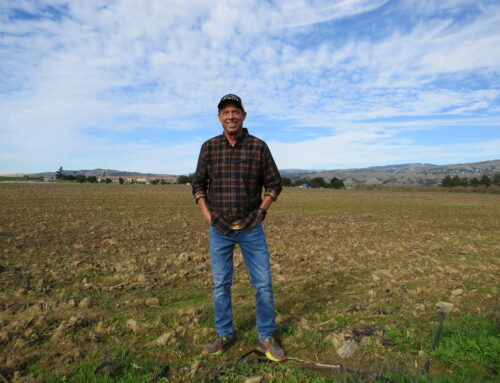5-2 vote also denied city’s plan to annex 71 acres at Watsonville/Monterey roads
Published in the March 30 – April 12, 2016 issue of Morgan Hill Life
By Marty Cheek

Photo by Marty Cheek
A worker plows under mustard plants in a field in the city’s Southeast Quadrant, the subject of a controversial annexation project.
After several hours of comments from members of the public, the county’s Local Area Formation Commission members voted 5-2 March 11 to deny the city of Morgan Hill’s requested annexation of 229 acres of the 1,195-acre Southeast Quadrant. Commissioners also voted against the city’s proposed annexation of 71 acres of unincorporated land in the Watsonville-Monterey roads region.
LAFCO Commissioner and Vice Chair Mike Wasserman, who is also a county supervisor, and LAFCO Chair Cat Tucker voted in favor of the annexation of the SEQ.
“I thought LAFCO got the vote right. It was a vote that said the LAFCO policies are pretty clear: Let’s do our best to maximize and make efficient the land we have inside cities first,” said Andrea Mackenzie, general manager of the Santa Clara Valley Open Space Authority, which lobbied against the annexations.
There may be “incidents” in the future where development might be built in the SEQ, but this is not the case there yet, she said.
“Let’s work together to come up with a coordinated program for protecting agricultural lands. There are people who want to farm land who maybe aren’t there now,” she said. “The Open Space Authority is very encouraged and looks forward to working with the county on the sustainable ag conservation program for southern Santa Clara County…. I think the citizens understand that we need farm land and we need wild spaces. That’s part of the quality of life here. And it does not take away for the need for housing and a strong economy — we can have both.”
The OSA is working with Santa Clara County on the Sustainable Agricultural Lands Conservation Strategy Grant to develop a regional policy for preserving agriculture and reducing greenhouse gas emissions.
County Supervisor David Cortese seeks to preserve the farming heritage of the south Santa Clara County region and said he was pleased with the outcome of the LAFCO vote.
“We’re still losing agricultural land in half-lives and my colleagues on the board of supervisors like Cindy Chavez joined me in the effort to stop that loss,” he said. “Just recently, we accepted a $100,000 grant from the state to develop a strategy to preserve those agricultural lands, which employs almost 10,000 employees in the valley and about 15,000 overall, which would make agricultural the biggest private sector employer in the valley on any given day. We need to preserve that and we know that.”
The city of Morgan Hill sought to annex the 229 SEQ acres to allow for the development of a private high school on land purchased by the Catholic Diocese of San Jose, a baseball/softball complex, various indoor and outdoor recreational and sports facilities, and commercial businesses such as retail stores, hotels and service stations. The city would like to see this area grow as a sports-recreation-leisure destination that will help build Morgan Hill’s brand as a youth sports community and bring visitors here, thus enhancing economic development.
“The Diocese continues to acknowledge the need for a Catholic high school in the South County and intends to hold on to the land,” said Father Steve Kim of the Diocese of San Jose who serves as the chairman of the high school committee.“The campaign for the school is currently evaluating its options.”
Morgan Hill City Manager Steve Rymer told council members at the March 16 meeting that “numerous hours” had been given by city staff to develop the annexation plan to LAFCO and the city’s work to preserve the ag land in the SEQ will not end because of the denial.
“Even though the decision by LAFCO was to deny both parts of the application, we still truly believe we have the same goals in mind, especially when it comes to the ag preservation,” he said. “As we move forward one of our goals obviously is to work with others in order to make sure that happens in Morgan Hill.”
Councilmember Larry Carr said he attended the meeting and spoke during the public comments.
“I was disappointed obviously in the outcome,” he told fellow council members. “I don’t think too many of us were surprised.”
There’s an uncertainty about what steps now need to be made to preserve SEQ farmland, now that the county and the OSA want to play the $40 million in state cap-and-trade funds plan, he said. This money won’t be available until 2017 and there is no guarantee how much, if any, Santa Clara County would receive for the SEQ.
The city of Morgan Hill has worked for more than 10 years on the SEQ annexation plan, and yet the county is asking the community to continue waiting as the new process continues, Carr said. He also would like to know how involved the county and OSA will allow the city to be in working with them in their proposed plan using the state’s Sustainable Agricultural Lands Conservation (SALC) program.
“There was lots of talk about this new county and Open Space Authority-led planning process for agriculture and lots of talk that Morgan Hill should wait for that, and the community should wait for that,” Carr said. “I’d like to ask the county to come down here and talk to us about that.”




